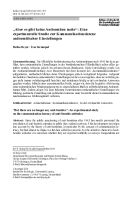„Aber es gibt keine Antisemiten mehr“: Eine experimentelle Studie zur Kommunikationslatenz antisemitischer Einstellungen
Translated Title
“But there are no longer any anti-Semites”: An experimental study on the communication latency of anti-Semitic attitudes
Author(s)
Publication Name
Publication Date
Abstract
Die öffentliche Sanktionierung des Antisemitismus nach 1945 hat dazu geführt, dass antisemitische Einstellungen in der bundesdeutschen Öffentlichkeit selten offen geäußert werden, teilweise jedoch im privaten Raum überdauern. Diese Entwicklung wurde von der Antisemitismusforschung zwar theoretisch mit dem Konzept der „Kommunikationslatenz“ aufgearbeitet, methodisch blieben diese Überlegungen jedoch weitgehend folgenlos. Aufgrund des heiklen Charakters antisemitischer Einstellungen ist davon auszugehen, dass sie in Befragungen nicht immer wahrheitsgemäß berichtet und stattdessen häufig sozial erwünschte Antworten gegeben werden. Mittels einer experimentellen Studie zeigen wir, dass die kognitive Aktivierung einer antisemitischen Primärgruppennorm zu einem höheren Maß an selbstberichtetem Antisemitismus führt. Zudem zeigen wir, dass bekannte Determinanten antisemitischer Einstellungen wie Bildung, politische Einstellung und politisches Interesse unter Kontrolle dieses Kommunikationsmechanismus an Erklärungskraft verlieren.
Translated Abstract
Since the public sanctioning of anti-Semitism after 1945 has mostly prevented the articulation of anti-Semitic attitudes in public they outlast in private. This development was taken into account by the theory of anti-Semitism, in particular by the concept of communication latency, but had almost no impact on the data collection process. For the sensitive character of anti-Semitic attitudes it is uncertain whether they are reported truthfully in surveys. Respondents are assumed to answer in a socially desirable manner. Using an experimental setting, we demonstrate that the cognitive activation of an anti-Semitic primary group norm increases the prevalence of self-reported anti-Semitism. In addition, we show that under statistical control of this communication mechanism the explanatory power of established determinants of anti-Semitic attitudes such as education, political attitudes, and political interest decreases.
Topics
Genre
Geographic Coverage
Copyright Info
This is an open access article distributed under the terms of the Creative Commons Attribution Noncommercial License (https://creativecommons.org/licenses/by-nc/2.0), which permits any noncommercial use, distribution, and reproduction in any medium, provided the original author(s) and source are credited.
Original Language
Volume/Issue
62
Page Number / Article Number
681–705
DOI
Bibliographic Information
„Aber es gibt keine Antisemiten mehr“: Eine experimentelle Studie zur Kommunikationslatenz antisemitischer Einstellungen. 2010: 681–705. https://archive.jpr.org.uk/10.1007/s11577-010-0115-0




